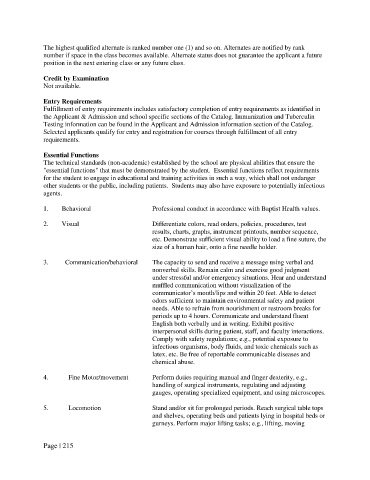Page 215 - 2020-2021 Catalog June
P. 215
The highest qualified alternate is ranked number one (1) and so on. Alternates are notified by rank
number if space in the class becomes available. Alternate status does not guarantee the applicant a future
position in the next entering class or any future class.
Credit by Examination
Not available.
Entry Requirements
Fulfillment of entry requirements includes satisfactory completion of entry requirements as identified in
the Applicant & Admission and school specific sections of the Catalog. Immunization and Tuberculin
Testing information can be found in the Applicant and Admission information section of the Catalog.
Selected applicants qualify for entry and registration for courses through fulfillment of all entry
requirements.
Essential Functions
The technical standards (non-academic) established by the school are physical abilities that ensure the
"essential functions" that must be demonstrated by the student. Essential functions reflect requirements
for the student to engage in educational and training activities in such a way, which shall not endanger
other students or the public, including patients. Students may also have exposure to potentially infectious
agents.
1. Behavioral Professional conduct in accordance with Baptist Health values.
2. Visual Differentiate colors, read orders, policies, procedures, test
results, charts, graphs, instrument printouts, number sequence,
etc. Demonstrate sufficient visual ability to load a fine suture, the
size of a human hair, onto a fine needle holder.
3. Communication/behavioral The capacity to send and receive a message using verbal and
nonverbal skills. Remain calm and exercise good judgment
under stressful and/or emergency situations. Hear and understand
muffled communication without visualization of the
communicator’s mouth/lips and within 20 feet. Able to detect
odors sufficient to maintain environmental safety and patient
needs. Able to refrain from nourishment or restroom breaks for
periods up to 4 hours. Communicate and understand fluent
English both verbally and in writing. Exhibit positive
interpersonal skills during patient, staff, and faculty interactions.
Comply with safety regulations; e.g., potential exposure to
infectious organisms, body fluids, and toxic chemicals such as
latex, etc. Be free of reportable communicable diseases and
chemical abuse.
4. Fine Motor/movement Perform duties requiring manual and finger dexterity, e.g.,
handling of surgical instruments, regulating and adjusting
gauges, operating specialized equipment, and using microscopes.
5. Locomotion Stand and/or sit for prolonged periods. Reach surgical table tops
and shelves, operating beds and patients lying in hospital beds or
gurneys. Perform major lifting tasks; e.g., lifting, moving
Page | 215

